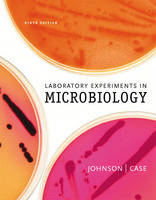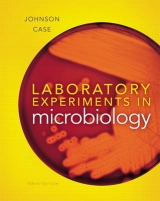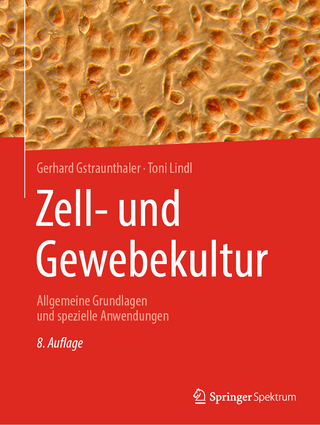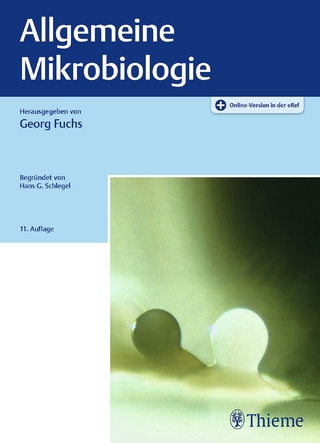
Laboratory Experiments in Microbiology
Pearson (Verlag)
978-0-321-56028-5 (ISBN)
- Titel erscheint in neuer Auflage
- Artikel merken
Ted R. Johnson is a professor of biology at St. Olaf College, a liberal arts college in Northfield, Minnesota, where he teaches courses in microbiology and immunology. He has taught at St. Olaf for 31 years and previously taught at Mankato State University. He received his master’s degree and his Ph.D in microbiology from the University of Illinois in Chicago, Illinois. While at St. Olaf College, he has developed and directed several abroad semester and interim programs. His research focuses on the immune response to virally induced cancer in various animal models. Christine L. Case is a registered microbiologist and a professor of microbiology at Skyline College in San Bruno, California, where she has taught for the past 38 years. She received her Ed. D. in curriculum and instruction from Nova Southeastern University and her M.A. in microbiology from San Francisco State University. She was Director for the Society for Industrial Microbiology (SIM). She received the ASM and California Hayward outstanding educator awards and SACNAS Mentor award. In addition to teaching, Chris contributes regularly to professional literature, develops innovative educational methodologies, and maintains a personal and professional commitment to conservation and the importance of science in society. Chris is also an avid photographer, and many of her photographs appear in this lab manual.
Introduction
I. MICROSCOPY
1. Use and Care of the Microscope
2. Examination of Living Microorganisms
II. Handling Bacteria
3. Microbes in the Environment
4. Transfer of Bacteria: Aseptic Techniques
III. STAINING METHODS
5. Preparation of Smears and Simple Staining
6. Negative Staining
7. Gram Staining
8. Acid-fast Staining
9. Structural Stains (Endospore, Capsule, Flagella)
10. Morphologic Unknown
IV. CULTIVATION OF BACTERIA.
11. Isolation of Bacteria by Dilution Technique
12. Special Media for Isolating Bacteria
V. MICROBIAL METABOLISM
13. Carbohydrate Catabolism
14. Fermentation
15. Protein Catabolism, Part 1
16. Protein Catabolism, Part 2
17. Respiration
18. Unknown Identification and Bergey’s Manual
VI. MICROBIAL GROWTH
19. Oxygen and the Growth of Bacteria
20. Determination of a Bacterial Growth Curve: The Role of Temperature
21. Biofilms
VII. CONTROL OF MICROBIAL GROWTH
22. Physical Methods of Control: Heat
23. Physical Methods of Control: Ultraviolet Radiation
24. Chemical Methods of Control: Disinfectants and Antiseptics
25. Chemical Methods of Control: Antimicrobial Drugs
26. Effectiveness of Hand Scrubbing
VIII. MICROBIAL GENETICS
27. Regulation of Gene Expression
28. Isolation of Bacterial Mutants
29. Transformation of Bacteria
30. DNA Fingerprinting
31. Genetic Engineering
32. Ames Test for Detecting Possible Chemical Carcinogens
IX. THE MICROBIAL WORLD
33. Fungi: Yeasts and Molds
34. Phototrophs: Algae and Cyanobacteria 35. Protozoa
36. Parasitic Helminths
X. VIRUSES
37. Isolation and Titration of Bacteriophages
38. Plant Viruses
XI. INTERACTION OF MICROBE AND HOST
39. Epidemiology
40. Koch’s Postulate
XII. IMMUNOLOGY
41. Nonspecific Resistance
42. Blood Group Determination: Slide Agglutination
43. Agglutination Reactions: Microtiter Agglutination
44. ELISA Technique
XIII. MICROORGANISMS AND DISEASE
45. Bacteria of the Skin
46. Bacteria of the Respiratory Tract
47. Bacteria of the Mouth
48. Bacteria of the Gastrointestinal Tract
49. Bacteria of the Genitourinary Tract
50. Rapid Identification Methods
51. Identification of an Unknown from a Clinical Sample
XIV. MICROBIOLOGY AND THE ENVIRONMENT
52. Microbes in Water: Multiple-Tube Technique
53. Microbes in Water: Membrane Filter Technique
54. Microbes in Food: Contamination
55. Microbes Used in the Production of Foods
56. Microbes in Soil: The Nitrogen and Sulfur Cycles
57. Microbes in Soil: Bioremediaton
APPENDICES
A. Pipetting
B. Dilution Techniques and Calculations
C. Use of the Spectrophotometer
D. Graphing
E. Use of the Dissecting Membrane
F. Use of the Membrane Filter
G. Electrophoresis
H. Keys to Bacteria
Index
| Erscheint lt. Verlag | 9.4.2009 |
|---|---|
| Sprache | englisch |
| Maße | 216 x 279 mm |
| Gewicht | 980 g |
| Themenwelt | Naturwissenschaften ► Biologie ► Mikrobiologie / Immunologie |
| ISBN-10 | 0-321-56028-0 / 0321560280 |
| ISBN-13 | 978-0-321-56028-5 / 9780321560285 |
| Zustand | Neuware |
| Informationen gemäß Produktsicherheitsverordnung (GPSR) | |
| Haben Sie eine Frage zum Produkt? |
aus dem Bereich



